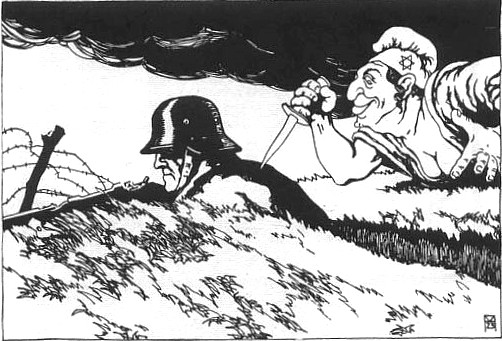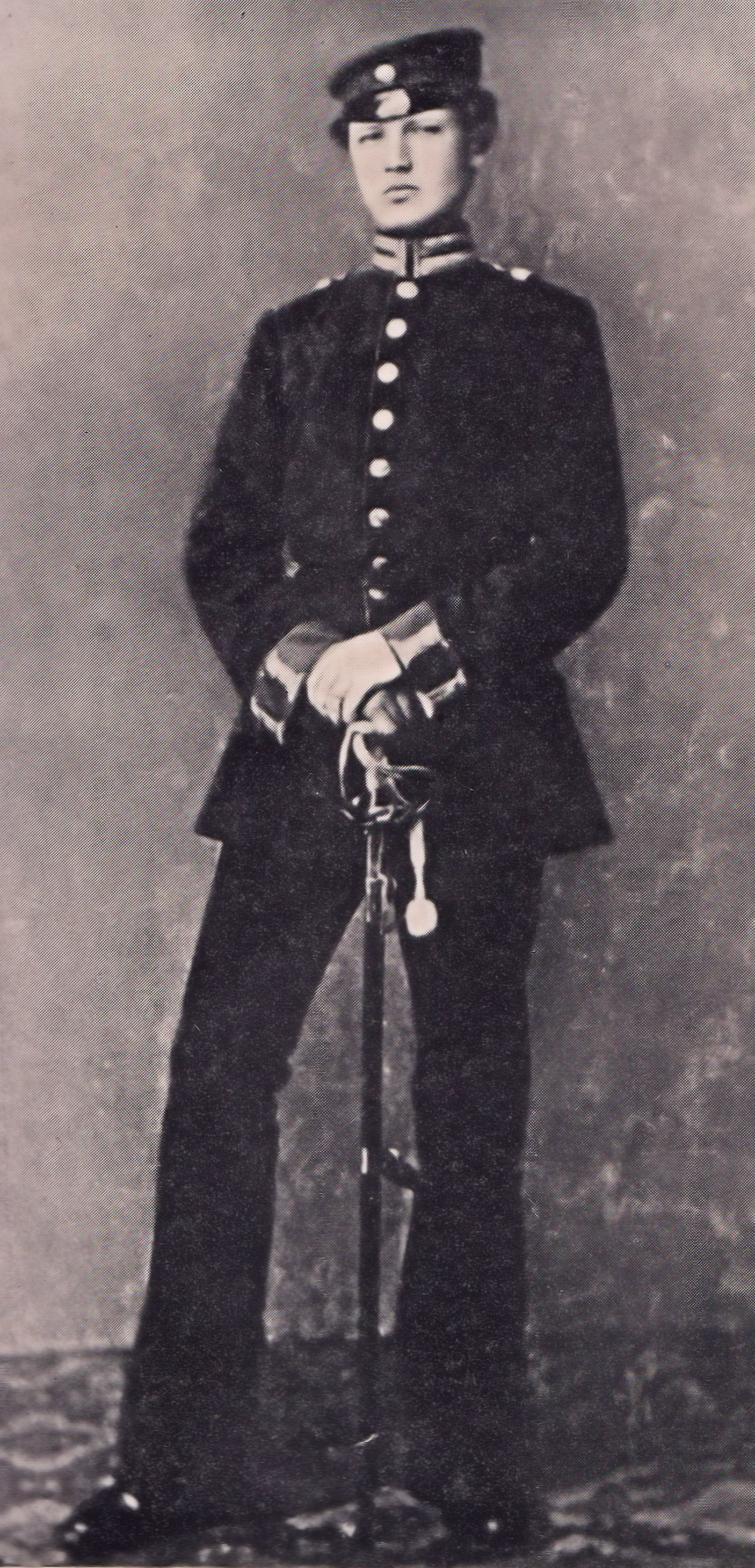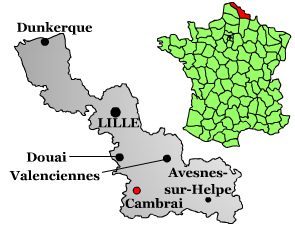|
Stab In The Back
The stab-in-the-back myth (, , ) was an antisemitic and anti-communist conspiracy theory that was widely believed and promulgated in Germany after 1918. It maintained that the Imperial German Army did not lose World War I on the battlefield, but was instead betrayed by certain citizens on the home front – especially Jews, revolutionary socialists who fomented strikes and labour unrest, and republican politicians who had overthrown the House of Hohenzollern in the German Revolution of 1918–1919. Advocates of the myth denounced the German government leaders who had signed the Armistice of 11 November 1918 as the "November criminals" (). When Adolf Hitler and the Nazi Party rose to power in 1933, they made the conspiracy theory an integral part of their official history of the 1920s, portraying the Weimar Republic as the work of the "November criminals" who had "stabbed the nation in the back" in order to seize power. Nazi propaganda depicted Weimar Germany as "a morass of ... [...More Info...] [...Related Items...] OR: [Wikipedia] [Google] [Baidu] |
Weimar Republic
The Weimar Republic, officially known as the German Reich, was the German Reich, German state from 1918 to 1933, during which it was a constitutional republic for the first time in history; hence it is also referred to, and unofficially proclaimed itself, as the German Republic. The period's informal name is derived from the city of Weimar, which hosted the constituent assembly that established its government. In English, the republic was usually simply called "Germany", with "Weimar Republic" (a term introduced by Adolf Hitler in 1929) not commonly used until the 1930s. The Weimar Republic had a semi-presidential system. Toward the end of the First World War (1914–1918), Germany was exhausted and suing for peace, sued for peace in desperate circumstances. Awareness of imminent defeat sparked a German Revolution of 1918–1919, revolution, Abdication of Wilhelm II, the abdication of Kaiser Wilhelm II, the proclamation of the Weimar Republic on 9 November 1918, and formal cessa ... [...More Info...] [...Related Items...] OR: [Wikipedia] [Google] [Baidu] |
Reichstag (German Empire)
The Reichstag (, " Diet of the Realm"), of the German Empire was Germany's lower House of Parliament from 1871 to 1918. Within the governmental structure of the Reich, it represented the national and democratic element alongside the federalism of the Bundesrat and the monarchic and bureaucratic element of the executive, embodied in the Reich chancellor. Together with the Bundesrat, the Reichstag had legislative power and shared in decision-making on the budget. It also had certain rights of control over the executive branch and could engage the public through its debates. The emperor had little political power, and over time the position of the Reichstag strengthened with respect to both the imperial government and the Bundesrat. Reichstag members were elected for three-year terms from 1871 to 1888 and following that for five years. It had one of the most progressive electoral laws of its time: with only a few restrictions, all men 25 and older were allowed to vote, secretly and ... [...More Info...] [...Related Items...] OR: [Wikipedia] [Google] [Baidu] |
Erich Ludendorff
Erich Friedrich Wilhelm Ludendorff (; 9 April 1865 – 20 December 1937) was a German general and politician. He achieved fame during World War I (1914–1918) for his central role in the German victories at Battle of Liège, Liège and Battle of Tannenberg, Tannenberg in 1914. After his appointment as Generalquartiermeister, First Quartermaster General of the German General Staff in 1916, Ludendorff became Germany's chief policymaker in a Oberste Heeresleitung, ''de facto'' military dictatorship until the country's defeat in 1918. Later during the years of the Weimar Republic, he took part in the failed 1920 Kapp Putsch and Adolf Hitler's 1923 Beer Hall Putsch, thereby contributing significantly to the Adolf Hitler's rise to power, Nazis' rise to power. Erich Ludendorff came from a non-noble family in Kruszewnia (hence the lack of a "Nobiliary_particle, von" or "Nobiliary_particle, zu" in his name), in the Prussian Province of Posen. After completing his education as a cadet, h ... [...More Info...] [...Related Items...] OR: [Wikipedia] [Google] [Baidu] |
Paul Von Hindenburg
Paul Ludwig Hans Anton von Beneckendorff und von Hindenburg (2 October 1847 – 2 August 1934) was a German military and political leader who led the Imperial German Army during the First World War and later became President of Germany (1919–1945), President of Germany from 1925 until his death in 1934. He played a key role in the Nazi seizure of power in 1933 when he appointed Adolf Hitler as Chancellor of Germany. Hindenburg was born to a family of minor Prussian nobility in the Grand Duchy of Posen. Upon completing his education as a cadet, he enlisted in the Third Regiment of Foot Guards as a second lieutenant. He saw combat during the Austro-Prussian War, Austro-Prussian and Franco-Prussian War, Franco-Prussian wars. In 1873, he was admitted to the prestigious Preußische Hauptkadettenanstalt, War Academy in Berlin, where he studied before being appointed to the General Staff Corps. In 1885, he was promoted to major and became a member of the German General Staff. After ... [...More Info...] [...Related Items...] OR: [Wikipedia] [Google] [Baidu] |
Generalfeldmarschall
''Generalfeldmarschall'' (; from Old High German ''marahscalc'', "marshal, stable master, groom"; ; often abbreviated to ''Feldmarschall'') was a rank in the armies of several German states and the Holy Roman Empire, (''Reichsgeneralfeldmarschall''); in the Habsburg monarchy, the Austrian Empire and Austria-Hungary, the rank ''Feldmarschall'' was used. The rank was the equivalent to ''Großadmiral'' () in the '' Kaiserliche Marine'' and ''Kriegsmarine'', a five-star rank, comparable to OF-10 in today's NATO naval forces. Austrian Empire and Austria-Hungary Paroli (uniform) The rank existed in the Austrian Empire as ''Kaiserlicher Feldmarschall'' ("imperial field marshal") and in Austria-Hungary as '' Kaiserlicher und königlicher Feldmarschall'' - ''Császári és királyi tábornagy'' ("imperial and royal field marshal"). Both were based on prior usage during the Holy Roman Empire. The Emperor-King held the rank ''ex officio'', other officers were promoted as required. Betw ... [...More Info...] [...Related Items...] OR: [Wikipedia] [Google] [Baidu] |
Hindenburg Programme
The Hindenburg Programme was a First World War armaments and economic policy begun in late 1916 by the heads of the German General Staff, Field Marshal Paul von Hindenburg and General Erich Ludendorff. Its goal was to make the most efficient use of civilian and military resources vastly to increase Germany production of weapons and munitions. The Programme established a (War Office) under the command of General Wilhelm Groener to create a command economy for the German Empire. The Auxiliary Services Act of 1916 required all men from 17 to 60 years of age who were not already in the armed forces or the war economy to render national service during the war. The Hindenburg Programme failed to reach its goals or change the course of the war. The labour provisions that were added to the Auxiliary Services Act to get it through the granted important concessions to workers. Background Third OHL On 29 August 1916, Field Marshal Paul von Hindenburg and General Erich Ludendorff were appo ... [...More Info...] [...Related Items...] OR: [Wikipedia] [Google] [Baidu] |
Auxiliary Services Act (1916)
The Auxiliary Services Act () was a law of the German Empire introduced during the First World War on 6 December 1916 to facilitate the Hindenburg Programme, an attempt by the military to mobilize scarce resources, including manpower, more efficiently for the war effort. Under the terms of the act, every German male from the age of seventeen to sixty, unless he had been called up for service in the armed forces, was obligated to render national service during the war (§ 1). The types of workers considered to be in the national auxiliary service included those employed by public authorities, official agencies, war industries, agriculture and forestry, nursing, war-related organizations of any kind, or "in other occupations and trades that are directly or indirectly significant to waging war or economic regulation" (§ 2). The Law on the Patriotic Auxiliary Service marked a significant stage towards total war and, in the long run, in the development of German labor law. The law wa ... [...More Info...] [...Related Items...] OR: [Wikipedia] [Google] [Baidu] |
Oberste Heeresleitung
The ''Oberste Heeresleitung'' (, "Supreme Army Command", OHL) was the highest echelon of command of the army (''Heer'') of the German Empire. In the latter part of World War I, the Third OHL assumed dictatorial powers and became the ''de facto'' political authority in the Empire. Formation and operation After the formation of the German Empire in 1871, the Prussian Army, Royal Saxon Army, Army of Württemberg and the Bavarian Army were autonomous in peacetime, each kingdom maintaining a separate war ministry and general staff to administer their forces. On the outbreak of war, the Constitution of the German Empire made the German Emperor commander-in-chief of the combined armies (''Oberster Kriegsherr'', "supreme warlord"). The Emperor's role as commander-in-chief was largely ceremonial and authority lay with the Chief of the German General Staff, who issued orders in the Emperor's name. The pre-war Chief of the General Staff was Colonel General Helmuth von Moltke and the ' ... [...More Info...] [...Related Items...] OR: [Wikipedia] [Google] [Baidu] |
American Entry Into World War I
The United States entered into World War I on 6 April 1917, more than two and a half years after the war began in Europe. Apart from an Anglophile element urging early support for the United Kingdom of Great Britain and Ireland, British and an anti-Tsarist element sympathizing with German Empire, Germany's war against Russian Empire, Russia, American public opinion had generally reflected a desire to stay out of the war. Over time, especially after reports of The Rape of Belgium, German atrocities in Belgium in 1914 and after the Sinking of the RMS Lusitania, sinking attack by the Imperial German Navy submarine (U-boat) torpedoing of the trans-Atlantic ocean liner off the southern coast of Ireland in May 1915, Americans increasingly came to see Imperial Germany as the aggressor in Europe. While the country was at peace, American banks made huge loans to the Allies of World War I, Entente powers (Allies), which were used mainly to buy munitions, raw materials, and food from acros ... [...More Info...] [...Related Items...] OR: [Wikipedia] [Google] [Baidu] |
Nazi Germany
Nazi Germany, officially known as the German Reich and later the Greater German Reich, was the German Reich, German state between 1933 and 1945, when Adolf Hitler and the Nazi Party controlled the country, transforming it into a Totalitarianism, totalitarian dictatorship. The Third Reich, meaning "Third Realm" or "Third Empire", referred to the Nazi claim that Nazi Germany was the successor to the earlier Holy Roman Empire (800–1806) and German Empire (1871–1918). The Third Reich, which the Nazis referred to as the Thousand-Year Reich, ended in May 1945, after 12 years, when the Allies of World War II, Allies defeated Germany and entered the capital, Berlin, End of World War II in Europe, ending World War II in Europe. After Hitler was appointed Chancellor of Germany in 1933, the Nazi Party began to eliminate political opposition and consolidate power. A 1934 German referendum confirmed Hitler as sole ''Führer'' (leader). Power was centralised in Hitler's person, an ... [...More Info...] [...Related Items...] OR: [Wikipedia] [Google] [Baidu] |








